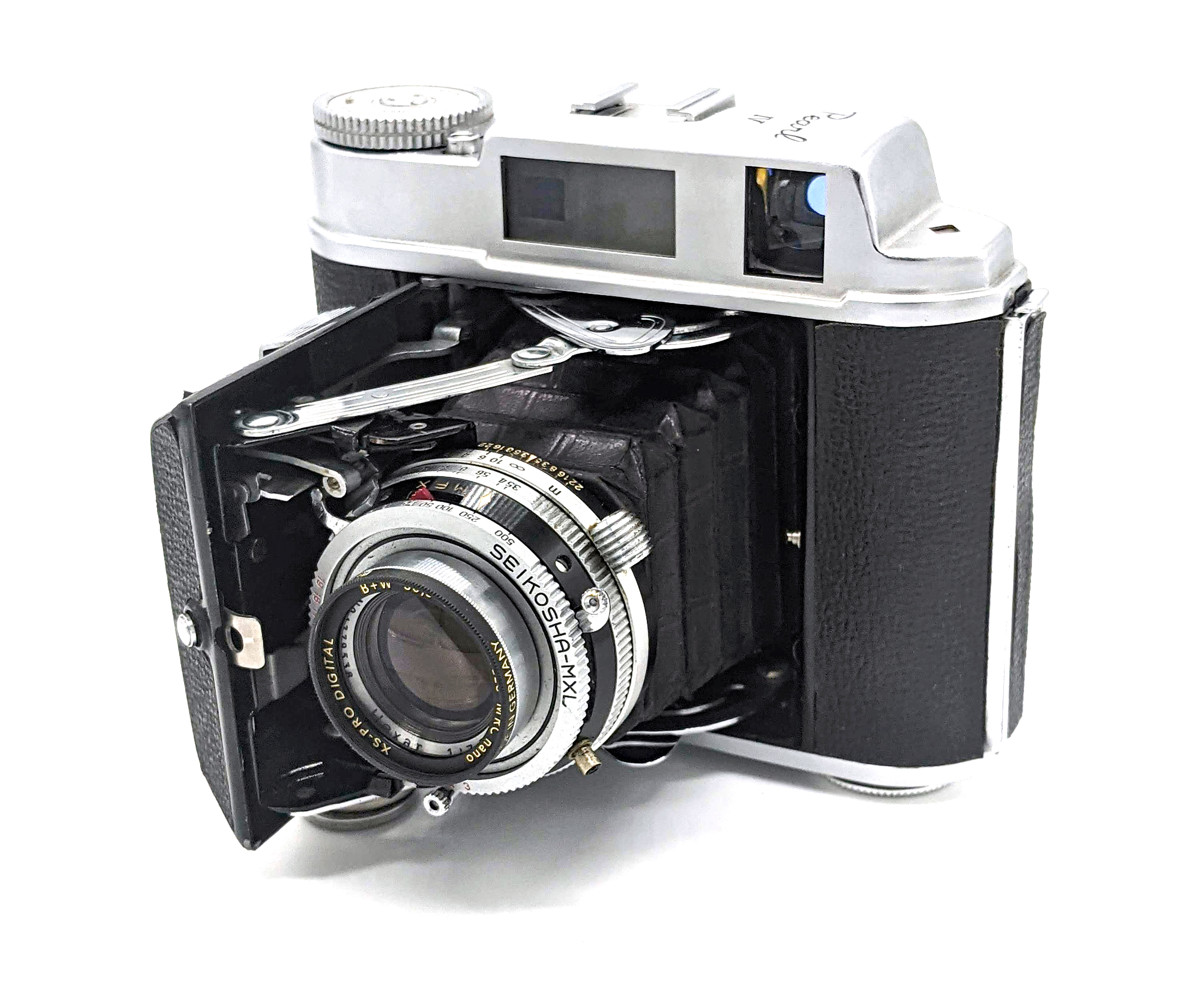
The Konica Pearl IV was a short-lived, Japanese-domestic-market-only medium format folding camera of exceptional quality that was produced from late 1958 to 1959. With the precipitous decline in the popularity of folding medium format cameras during the late 1950s, it disappeared from the market along with most others brands and would be Konica’s final attempt at the 645 format. Because the Pearl IV has been generally unknown outside of Japan, and because most Konica products of the 1950s were absolutely world-class, is it possible that the IV was the best “classic” 645 medium format folding camera? It makes an extremely good case.
Although folding cameras were produced by many different manufacturers all over the world, the Zeiss Ikon Ikonta series, produced between the early 1920s and late 1950s are probably the most famous. The post-war models included the Ikonta 524/15 (6×6), the Ikonta 524/12 (6×9), the Super Ikonta III (6×6), and the Super Ikonta IV (6×6). During the 1950s, other new, rangefinder-coupled folding cameras included the Voigtlander Bessa I and II (6×9), the Agfa Super Isolette (6×6), various iterations of the Mamiya 6 (6×6), and the different versions of the Olympus Six (6×6). An endemic problem with rangefinder-coupled folders, even in their final generations, was that their viewfinders were generally abysmal.
Introduced at the sunset of the folding camera era was the December 1958 Konishiroku (Konica) Pearl IV. However, because of its relatively low production, the fact that very few examples made their way out of Japan, and the general death of the folding camera, for decades not many people outside of Japan had actually put their hands on one. It does not appear that any well-known North American photography publication even reviewed the Pearl IV when it was produced. In recent history, online sellers (mostly Japan-based) have asked a lot of money for working examples, much more than any other common vintage folding camera. For many people, for the money, there are other attractive classic and modern alternatives in the 645 and 6×6 format.
So, is the Pearl IV a fun, usable 645 camera for the 21st century, or should it be confined to the climate-controlled cabinets of the camera collector crowd? Let’s take a look.
The Pearl II & III
Konica, whose origin reaches back to the 1870s, has a long and storied history as a famous optical and camera company in Japan until its ultimate demise in 2003. Although the history gets a little fuzzy, it appears that at least by 1909, Konica was producing a folding roll film camera. The grandmother of the Pearl line was the 1938 “Semi Pearl” — a non-rangefinder coupled 645 folder that may have been inspired by the contemporary Zeiss Ikonta. The Semi Pearl was produced before the war, sporadically during the war, and then for a short time after the war. In 1948, Konica introduced the “Pearl I,” which retained much of the physical appearance of the Semi Pearl while adding an “uncoupled” rangefinder, where the distance from the rangefinder would have to be dialed in manually to the lens.
The Pearl II (1950) and Pearl III (1955) were the immediate predecessors to the IV. The Pearl II featured a coupled combined viewfinder/rangefinder, a Konica-designed shutter with a top speed of 1/500, a choice of a f/4.5 or f/3.5 lens, an off-set cold shoe, swing-back film loading, a viewfinder lacking framelines or any parallax correction lines, and an interesting top-mounted “depth of field” calculator that automatically adjusted with the selected aperture. To take a photo, the shutter speed and aperture had to be set on the lens itself, the shutter had to cocked, and then the shutter release button is positioned on the top of the door (not where you think it would be on the top plate). The Pearl II’s film advance system will seem a bit bizarre. When advancing the film, one had to look through a small glass window through the back door that would read the frame number from the backing paper of the 120 film. The Pearl II had neither “double exposure prevention” nor did the film advance “lock” when advanced to the appropriate next frame. Thus, it would have been easy to double expose a shot if you forgot to advance the film, or you could advance the film too far if not paying attention to the film window.
Faced with newer, more-featured models from companies like Zeiss and Mamiya, Konica introduced the Pearl III in 1955. The last variant of the Pearl III, the IIIL, featured a coated version of the f/3.5 Hexar lens and a new Seikosha-produced leaf shutter (the MX). Shutter speeds again went up to 1/500, M/X/F flash synch capability was added (flash syncs at all shutter speeds), an off-set cold shoe sat on top, and the smallish viewfinder/rangefinder window still lacked framelines and any parallax marks. The most “innovative,” and now controversial, feature of the Pearl III was its “automatic stop” film advance. To make a long story short, once the film was loaded and the arrows on the film were lined up with the marks on the camera, one closed the back, and then flipped a lever on the bottom of the camera, that would engage the “auto” advance mechanism. Now, the bottom-positioned advance would automatically “stop” at the appropriate frame interval. In practice during the 1950s, this probably worked ok. However, as many people have reported, modern 120 paper backing is much thinner than it was during the 1950s. As a result, the auto stop mechanism does not often work as intended, either not leaving enough space between frames or, alternatively, too much. Folks have developed workarounds. However, the IIIL still lacked a double exposure prevention system.
Released during December 1958, the Pearl IV was a complete ground-up redesign of the Pearl III, essentially retaining only the lens and the shutter of the IIIL. Because the popularity of folding cameras had fallen so drastically during the 1950s, the IV was only produced for less than a year with only 4000 – 5000 built.
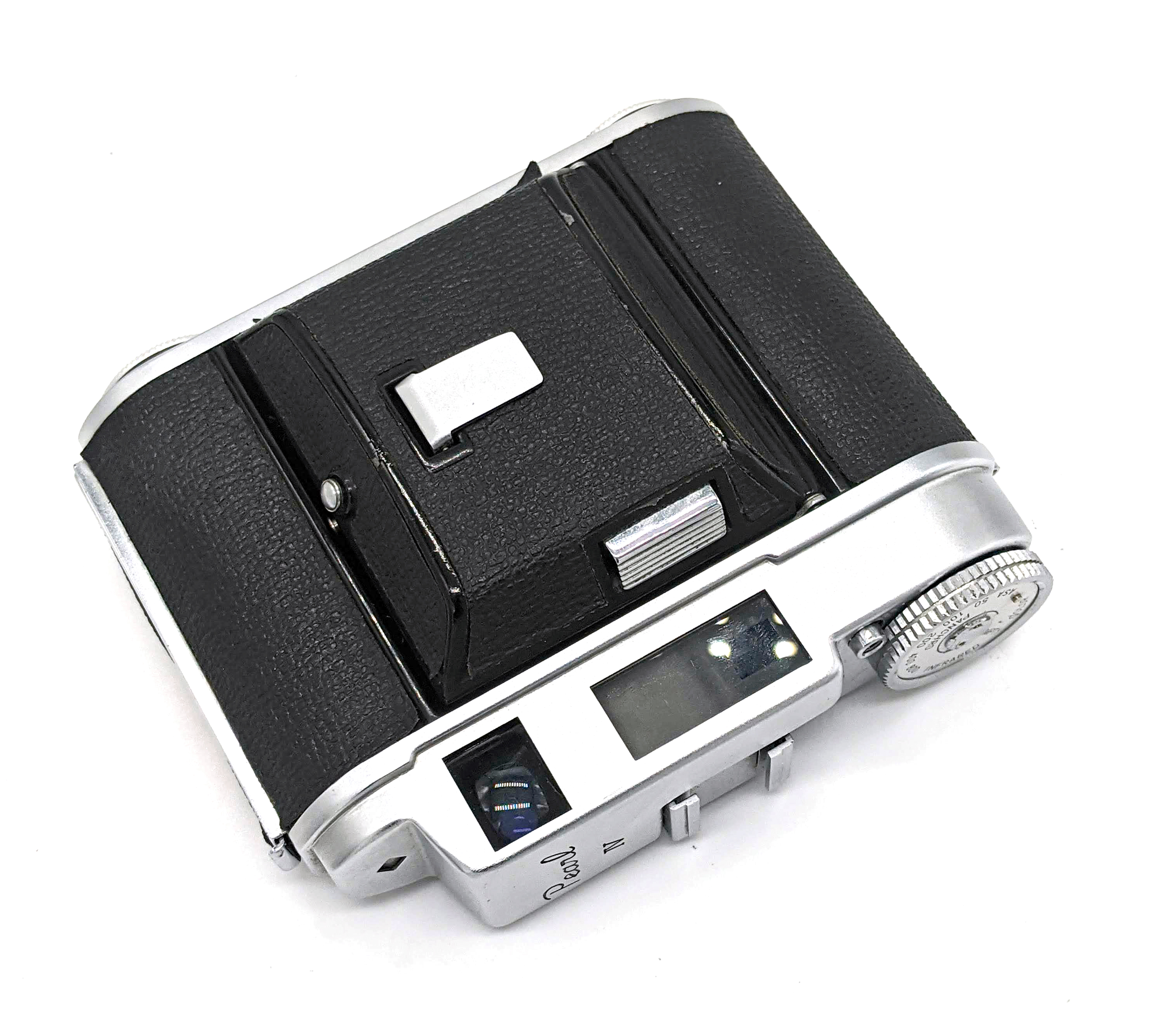
Specifications
| Format | 6 x 4.5 (120 Film Only) |
| Weight | 715g |
| Lens | 75mm f/3.5 Hexar |
| Filter Thread | 30.5mm |
| Minimum Focus | 1.20m |
| Shutter | Seikosha MXL |
| Shutter Speeds | B to 1/500 in Click Stops |
| Aperture Range | f/3.5 – f/32 in Click Stops |
| X Flash Sync | All Speeds |
| Parallax Correction | Etched in Viewfinder |
Operation
The IV’s most impressive upgrades over the III include a completely-redesigned brilliant viewfinder/rangefinder with actual framelines and etched parallax lines for close focusing, a far better and reliable automatic film advance mechanism, a centered cold shoe, double exposure prevention, and a traditionally-placed frame counter mechanism.
Viewfinder/Rangefinder: To me, what separates an excellent camera from the pack is the inclusion of a large, bright viewfinder. The IV does not disappoint in this regard. Indeed, there is probably no classic folder with a larger and brighter viewfinder. The projected framelines and rangefinder patch are very easy to see even in bright sunlight. Although the viewfinder is not automatically parallax-corrected (etched instead), I do not believe that any classic folder had such a feature.
Film Loading: The IV has straightforward and easy film loading that will be familiar to anyone who has used a modern medium format camera. The bottom dials rotate to “pop out” to permit placing the take-up spool and film in position. Once secured, the dials are turned to the red marks on the bottom plate to “lock” the take-up. Once you have lined up the arrows on the film paper with those on the body, close the swing back, and use the advance knob until it stops. At this point, the top frame counter will read “1.”
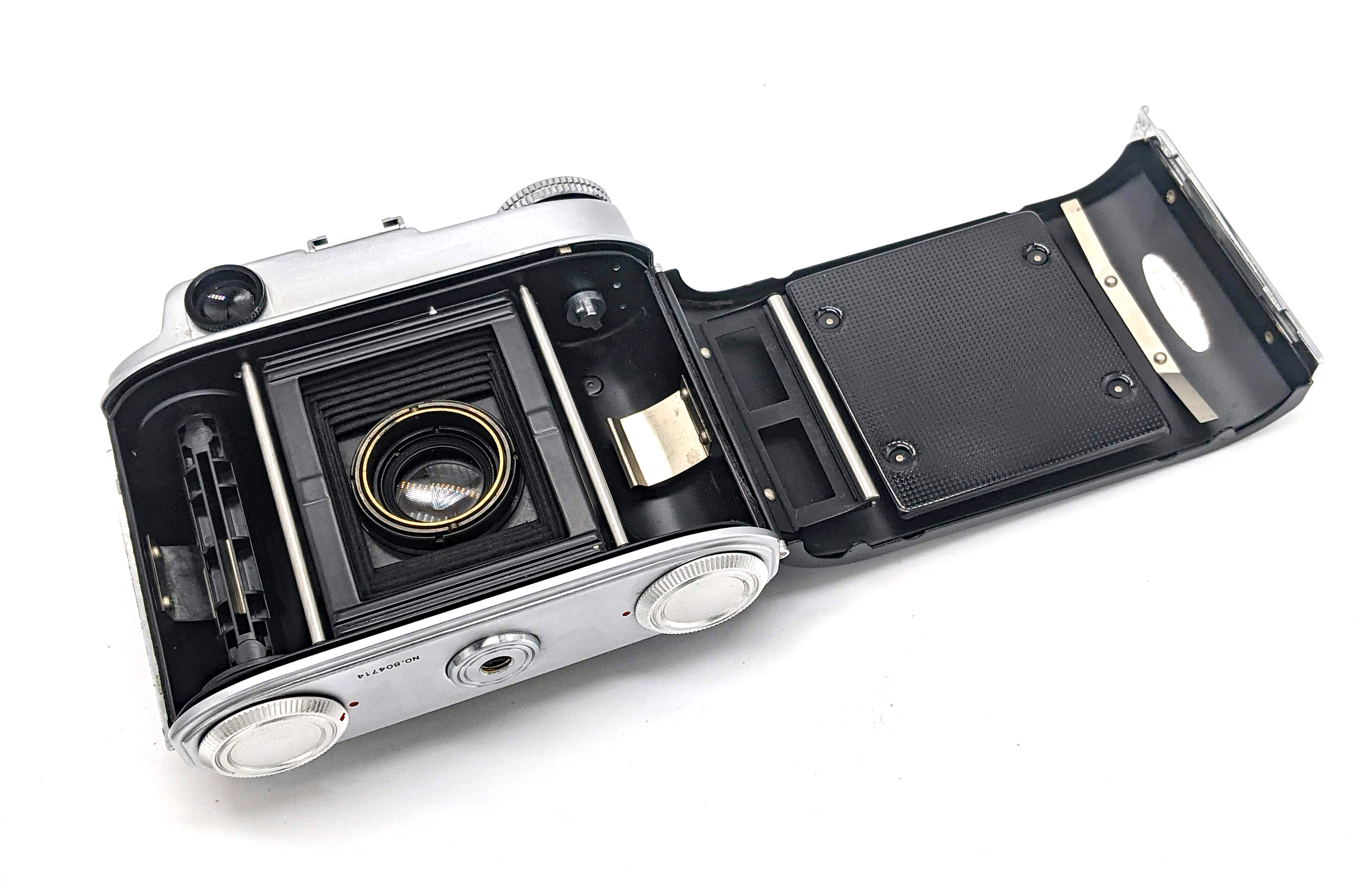
Operation: To take a photo with the IV, in no particular order, set the aperture and shutter speed on their respective dials on the lens assembly, focus, and cock the shutter. The shutter is tripped by pressing a rectangular button on the door. Then advance the film with the knob on the top of the camera until it stops. Repeat. The lens cannot be stowed unless it is focused at infinity. This is very, very important to remember.
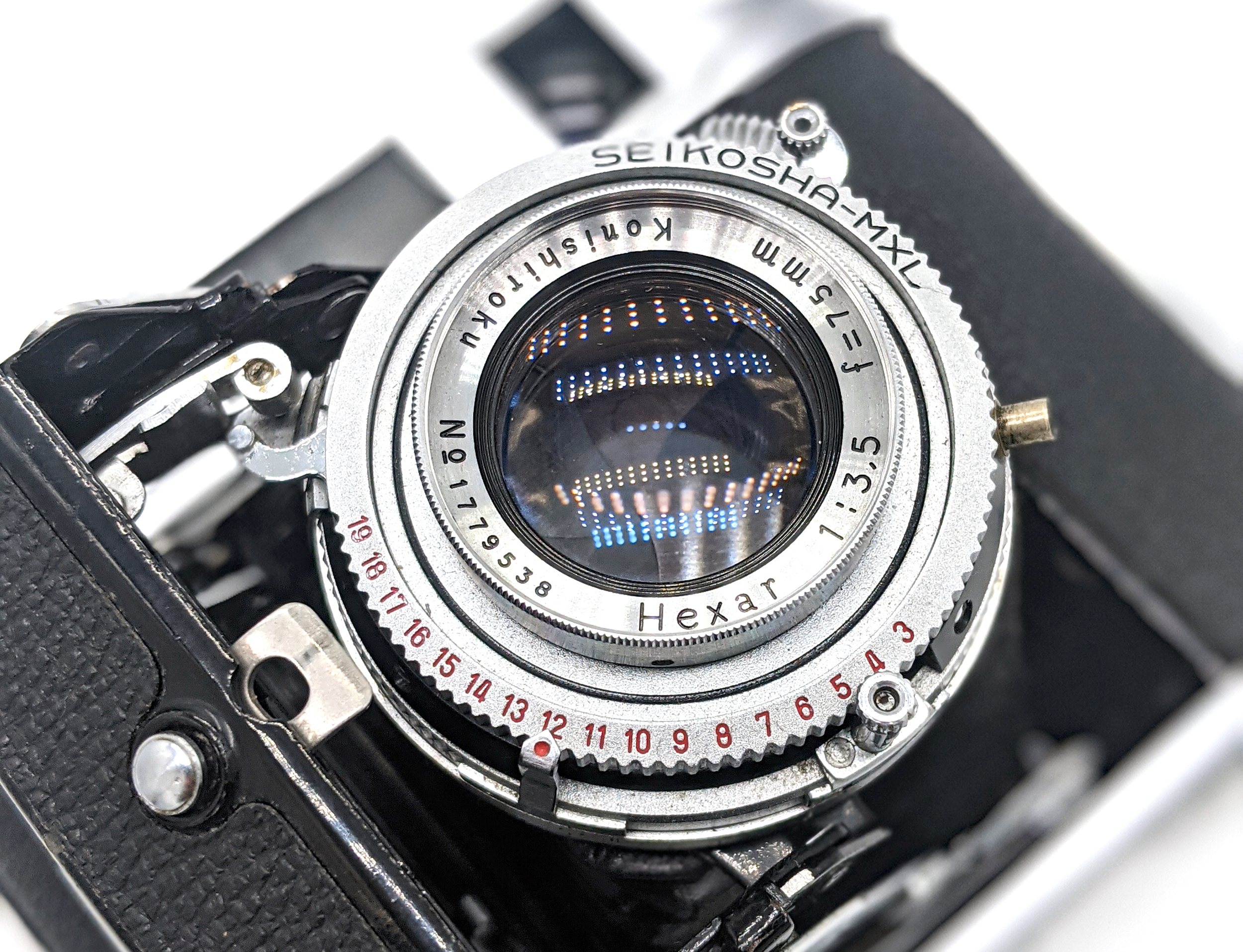
Cable Release: Where one would expect a shutter release button to be, the IV has a standard cable release socket. However, all the cable release socket does is mechanically trigger the door shutter button.
EV Coupled Exposure: In a feature also found on the contemporary Konica III 35mm rangefinder series, the Seikosha MXL shutter provides an option to set the EV for a scene instead of the aperture and shutter speeds separately. Setting an EV will permit you to rotate both the aperture and shutter speed dials together in the same ratio. In fact, the Seikosha unit defaults to that operation. If you want to set the shutter speeds and aperture independently, you need to push in the EV lever to let the aperture ring move independently of the shutter speed. This may seem somewhat annoying, but learning how to use the EV actually makes things easier because now you can choose the particular speed and aperture for the EV rating at the same time. However, as with all folders, setting exposure is a little cumbersome as you have to look at the front of the camera to set the actual selected EV value, instead of looking down at just the speed and aperture.
Traditional Film Counter: Unlike the III, the IV has a film counter window on the top plate.
Advanced Film Advance: Unlike the III, the IV has a more modern film advance that is not only immune to the III’s “backing paper thickness” issue, but also prevents double exposure as it is impossible to cock the shutter if the film has not been advanced to its next hard stop.
Centered Tripod Mount: Unlike the III, the IV has a traditional centered standard tripod mount.
The Optics: The 75mm f/3.5 Hexar is a stunning optic with Konica’s trademark 1950s amber lens coating. A 75mm 645 lens is equivalent to a 45mm lens in the 35mm format. The minimum focusing distance is only 1.20 meters.
Shutter Speeds: The IV uses the “older” style shutter speeds — so 1/10 for 1/15, 1/25 for 1/30, 1/50 for 1/60, 1/100 for 1/125. However, 1/250 and 1/500 are the same. It would not be until the 1960s that shutter speeds became uniform across manufacturers. However, the small variation in speeds should not throw off any exposures. The Seikosha MX shutter has a reputation of being fairly reliable but still may require service from time to time.
Pocketable: When folded, the IV is narrower than any practically 35mm fixed-lens rangefinder camera of the era, either fixed lens or interchangeable lens, yet obviously a bit taller.
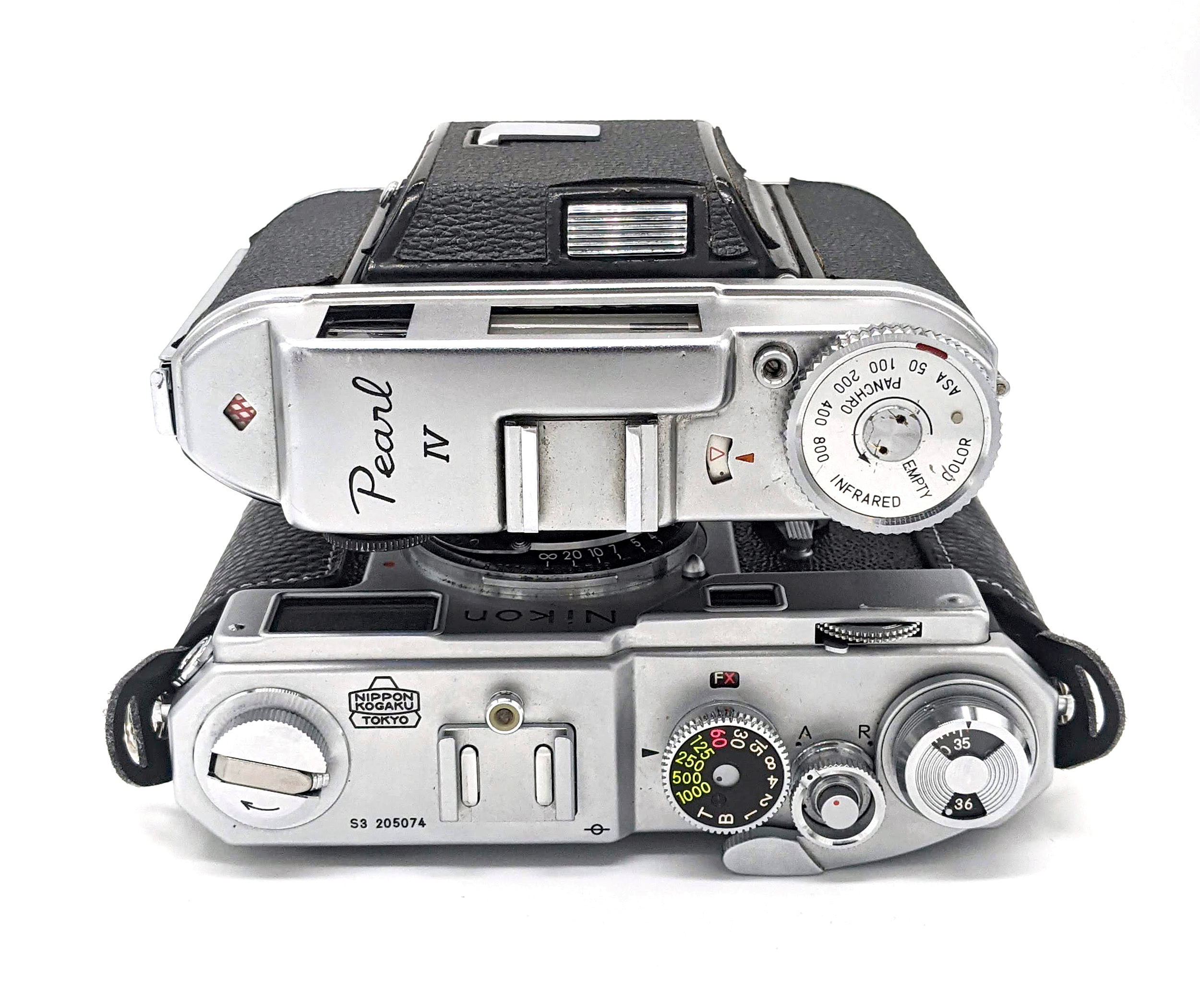
Handy Little Prop: Built-in to the lens door is a small metal hinge lever than allows the camera to prop itself up on a flat surface in its horizontal orientation. This may be useful to steady the camera for longer exposures on the fly.
Missing Features
Auto Cocking of the Shutter: Unlike the 1955 Mamiya 6 Automat, the IV did not include an “auto” shutter cocking mechanism. The 6 had a great feature that the advancing of the film also cocked the shutter for the next photo.
Traditional Shutter Button: The IV lacks a shutter button where you would expect it to be. Instead, as mentioned above, it has a cable release socket in its place. This is odd because the Konica III rangefinder series’ shutter button is nearly identical to that in the Pearl IV. It would have been easy enough to add a similar top plate shutter release.
Accessories
Case: The Pearl IV was sold with a proprietary two-part case which also doubled as the camera strap. It is highly advisable to purchase an example with the case as it is nearly impossible to find it as a standalone accessory. Because the Pearl IV lacks any strap lugs, the only other solution would be to find a strap that attaches to the bottom tripod mount.
Lens Hood: Pearl IV with a metal clamp on “Konihood” which is the same as that used on the Pearl III. However, any aftermarket 30.5mm screw-in hood will work. However, any hood must removed before collapsing the lens back into the body.

Konifilters: During the era, Konica produced a set of “Konifilters” in 30.5mm thread. However, it is always preferable to use modern multicoated filters over those from the 1950s. The plus side is that the lens can be folded in with any single filter attached.
Close Up Lenses: As with many rangefinder cameras of the era, the Pearl IV could accept two different “close up” lenses. A company called “Pleasant” produced a close-up accessory that could focus only between 1.00m and 0.5m and another that would focus between 0.6m to 0.4m. These Pleasant close up lenses, regardless of the system, are fascinating pieces as they permitted rangefinder to focus as closely as modern SLR lenses. With a medium format platform, these accessories can be very useful. Today, these are extraordinarily difficult accessories to find as they were proprietary to the IV only.

Flash: Konica produced a fold-up Koniflash that worked with normal flash bulbs of the time. Because no one really uses bulbs anymore, the IV works with all standard electronic flashes at all shutter speeds.
Compared
While the Pearl IV is an impressive 645 camera for the 1950s, it certainly had some competition.
Zeiss Ikon Super Ikonta IV 534/16 (6×6) (1956): The Ikonta IV has a strong claim to the title of best classic 6×6 folding camera. It checked the important boxes: a decent combined viewfinder/rangefinder, double exposure prevention, easy/conventional film loading, and the standard 75mm f/3.5 lens,. The Ikonta IV did not require that the lens be set to any particular focus point before closing. Over the Pearl IV, the Ikonta IV had a built-in primitive uncoupled selenium meter (most not working today), an 8-second delay self-timer, and a conventional shutter release on the top of camera. However, working Super Ikonta IVs are just as expensive on the used market as Pearl IVs.
Mamiya 6, Mark V (6×6 & 645) (1955): The very popular Mamiya 6s operate differently that the Ikonta IV or the Pearl IV. Instead of focusing with the actual lens, the 6 had a focusing dial on the back that moved the film plane rather than the lens assembly. Although the 6 went through a half-dozen or so versions during the 1950s, Model V appears to have been the most innovative with the ability to shoot in either 6×6 or 645 format (with an optional drop-in film mask). The 6 will impressively compensate its frame spacing to accommodate for 645. However, the 6’s viewfinder/rangefinder leaves some to be desired, it requires the installation of the pressure plate each time the film is changed.
Mamiya 6 Automat (6×6) (1955): The most impressive feature of the Automat is the ability for the camera to cock the shutter mechanically for the next shot at the end of the film advance. However, that is really the only feature that the Automat has over the Pearl IV. The Automat does not have double exposure prevention and did not have the capability to switch to 645.
Conclusions
Now that the Pearl IV has made its way out of Japan after many decades of relative obscurity, how does it compare? If you enjoy shooting the 645 format on a folding camera, the IV is clearly better than any of the pre-war folding camera models. If cost were not an option, it compares favorably with its contemporaries Its greatest selling features being the incredible viewfinder/rangefinder view, its ease of film loading, and its double exposure prevention. The IV also exhibits extremely fine craftsmanship, being solid and confidence-inspiring without being unnecessarily heavy. However, the IV is not necessarily an easy camera to use out in real life. Given the fact that the exposure settings and shutter cocking mechanism are on the lens itself, you may find yourself needing constantly to adjust the settings with changing light conditions. The lack of a shutter release in the traditional position is a little disappointing.
In the end, while relatively pricey, the IV is a wonderful 645 folding camera with solid build quality, an impressive viewfinder, and an extraordinary coated Konica lens. Despite its short list of shortcomings, I would highly recommend it if you are into the classic folding experience.